Spatial Configuration of Logistics Firms Relative to Cape Town International Airport, South Africa
Abstract
1. Introduction
2. Literature Review
2.1. Concentration of Logistics Facilities in the Vicinity of Airports
2.2. Metropolitan Areas and Regions as Logistics Hubs
2.3. Airfreight Catchment of Airports
2.4. Analysis of the Literature
3. Study Area
4. Research Design and Methods
4.1. Delimitation of the Study
- The land-use information, which classified the municipality in terms of the standard categories of residential, commercial, industrial, open space and so on, was the first port of call for the preliminary analysis. As a standard practice, these land-use categories are aggregated at the level of individual property to depict the dominant use on each property towards providing the land-use picture across the municipality. Given the connections between logistics facilities and industrial areas, the classes of ‘industrial’ and ‘commercial_industrial’ were split from the land-use shapefile so as to delineate the extent of the industrial areas in the metropolitan area.
- The non-residential land-use geodatabase was superimposed onto the aforementioned isolated industrial areas’ shapefile to cross-check the accuracy of the extent of the industrial areas. In most instances, the two datasets overlapped, which to a large degree reflected the accuracy of the information. However, the overlap was not perfect because of the minor changes that were introduced to the planning boundaries used by the municipality in different years, as well as urban development that had emerged post the compilation of the first set of data. In that regard, aerial photography (Google Maps) was utilised to verify the information further, particularly for the areas that were depicted by the non-residential data as having sizeable concentrations of development but were not part of the previous industrial land-use data. It should be noted that the information in the geodatabase reflected the non-residential uses broadly, without specifying the constituent components; hence, although useful, the data could not be used alone to ascertain the extent of the industrial areas.
4.2. Identification of the Logistics Firms (the Units of Analysis)
- The firms that were evidently not logistics-related in the manner of the paper were identified from the ‘usr_sic_desc’ field and deleted from the dataset. These included the firms with the following activity descriptions: waste ‘removal’; motion picture and video production and ‘distribution’; ‘removal’ of alien vegetation; ‘removal’ of asbestos; debt ‘removal’; wreck ‘removal’ dent ‘removal’; ‘supply’ of energy efficient technology; ‘supply’ of community-based service; blue cross services; earth ‘movers’; ‘distribution’ of student stipend.
- The records with duplicates were removed from the data so as to keep one record per firm. This was specifically in relation to the firms that had the same or similar names and were located at the same physical address. Some of these firms appeared to be based on ‘group of firms’ structure. A decision was therefore taken that such firms should be regarded as one entity, specifically in the instances where the firms were located at the same physical address.
- In the instances where there were overlaps resulting from the keyword search (i.e., the search yielding results on different logistics categories for a particular firm), a number of assumptions were employed towards classifying the affected firms. For instance, a firm that yielded ‘warehousing’ and other categories was classified under the category ‘warehousing’.
4.3. Spatial Analysis
- i = 1,…,n are the input points. Only include points in the sum if they are within the radius distance of the (x, y) location.
- popi = the population field value of point I, which is an optional parameter.
- disti = the distance between point i and the (x, y) location.
5. Results and Discussion
6. Conclusions
Author Contributions
Funding
Institutional Review Board Statement
Informed Consent Statement
Data Availability Statement
Conflicts of Interest
References
- Conway, M. Airport Cities 21: The New Global Transport Centers of the 21st Century; Conway Data: Atlanta, GA, USA, 1993. [Google Scholar]
- Kasarda, J.D. Airport cities. Urban Land 2009, 68, 56–60. [Google Scholar]
- Kasarda, J.D.; Lindsay, G. Aetrotropolis: The Way We’ll Live Next; Penguin Group: London, UK, 2011. [Google Scholar]
- Banai, R. The aerotropolis: Urban sustainability perspectives from the regional city. J. Transp. Land Use 2017, 10, 357–373. [Google Scholar] [CrossRef]
- Shukla, V.; Waddell, P. Firm location and land use in discrete urban space. A study of the spatial structure of Dallas-Fort Worth. Reg. Sci. Urban Econ. 1991, 21, 225–253. [Google Scholar] [CrossRef]
- Sivitanidou, R. Warehouse and distribution facilities and community attributes: An empirical study. Environ. Plan. 1996, 28, 1261–1278. [Google Scholar] [CrossRef]
- Raguraman, K. International air cargo hubbing: The case of Singapore. Asia Pac. Viewp. 1997, 38, 55–74. [Google Scholar] [CrossRef]
- McMillen, D.P.; McDonald, J.F. Suburban subcentres and employment density in metropolitan Chicago. J. Urban Econ. 1998, 43, 157–180. [Google Scholar] [CrossRef]
- Hong, J. Location determinants and patterns of foreign logistics services in Shanghai, China. Serv. Ind. J. 2007, 27, 339–354. [Google Scholar] [CrossRef]
- Warffemius, P.M.J. Modelling the Clustering of Distribution Centres around Amsterdam Airport Schiphol. Location Endowments, Economic Agglomeration, Locked-in Logistics and Policy Implications. Ph.D. Dissertation, TRAIL Research School, Delft, The Netherlands, 2007. [Google Scholar]
- Bowen, J.T. Moving places: The geography of warehousing in the US. J. Transp. Geogr. 2008, 16, 379–387. [Google Scholar] [CrossRef]
- Woudsma, C.; Jensen, J.F.; Kanaroglou, P.; Maoh, H. Logistics land use and the city: A spatial-temporal modelling approach. Transp. Res. Part E 2008, 44, 277–297. [Google Scholar] [CrossRef]
- McKinnon, A. The present and future land requirements of logistical activities. Land Use Policy 2009, 26S, S293–S301. [Google Scholar] [CrossRef]
- Raimbault, N.; Andriankaja, D.; Paffoni, E. Understanding the diversity of logistics facilities in the Paris region. Procedia -Soc. Behav. Sci. 2012, 39, 543–555. [Google Scholar] [CrossRef]
- Chhetri, P.; Butcher, T.; Corbitt, B. Characterising spatial logistics employment clusters. Int. J. Phys. Distrib. Logist. Manag. 2014, 44, 221–241. [Google Scholar] [CrossRef]
- Olsson, J.; Woxenius, J. Localisation of freight consolidation centres serving small road hauliers in a wider urban area: Barriers for more efficient freight deliveries in Gothenburg. J. Transp. Geogr. 2014, 34, 25–33. [Google Scholar] [CrossRef]
- Rivera, L.; Sheffi, Y.; Welsch, R. Logistics agglomeration in the US. Transp. Res. Part A Policy Pract. 2014, 59, 222–238. [Google Scholar] [CrossRef]
- Van den Heuvel, F.P.; Rivera, L.; Van Donselaar, K.H.; de Jong, A.; Sheffi, Y.; de Langen, P.W.; Fransoo, J.C. Relationship between freight accessibility and logistics employment in US counties. Transp. Res. Part A 2014, 59, 91–105. [Google Scholar] [CrossRef]
- Heitz, A.; Beziat, A. The parcel industry in the spatial organisation of logistics activities in the Paris region: Inherited spatial patterns and innovations in urban logistics systems. Transp. Res. Procedia 2016, 12, 812–824. [Google Scholar] [CrossRef]
- Önden, İ.; Acar, A.Z.; Eldemir, F. Evaluation of the logistics centre locations using a multi-criteria spatial approach. Transport 2016, 33, 322–334. [Google Scholar] [CrossRef]
- Coetzee, P.J.v.V.; Swanepoel, P.A. Spatial relationships and movement patterns of the air cargo industry in airport regions. J. Transp. Supply Chain Manag. 2017, 11, 1–10. [Google Scholar] [CrossRef]
- Heitz, A.; Launay, P.; Beziat, A. Rethinking data collection on logistics facilities: New approach for determining the number and spatial distribution of warehouses and terminals in metropolitan areas. Transp. Res. 2017, 2609, 67–76. [Google Scholar] [CrossRef]
- Kumar, I.; Zhalnin, A.; Kim, A.; Beaulieu, L.J. Transportation and logistics cluster competitive advantages in the U.S. regions: A cross-sectional and spatio-temporal analysis. Res. Transp. Anal. 2017, 61, 25–36. [Google Scholar] [CrossRef]
- Rolko, K.; Friedrich, H. Locations of logistics service providers in Germany—The basis for a new freight transport generation model. Transp. Res. Procedia 2017, 25, 1061–1074. [Google Scholar] [CrossRef]
- Holl, A.; Mariotti, I. The geography of logistic firm location: The role of accessibility. Netw. Spat. Econ. 2018, 18, 337–361. [Google Scholar] [CrossRef]
- Wang, D.; Gong, Z.; Yang, Z. Design of industrial clusters and optimization of land use in an airport economic zone. Land Use Policy 2018, 77, 288–297. [Google Scholar] [CrossRef]
- Yuan, Q. Location of warehouses and environmental justice: State of the Art. J. Plan. Lit. 2018, 33, 287–298. [Google Scholar] [CrossRef]
- Gingerich, K.; Maoh, H. The role of airport proximity on warehouse location and associated truck trips: Evidence from Toronto, Ontario. J. Transp. Geogr. 2019, 74, 97–109. [Google Scholar] [CrossRef]
- Strale, M. Logistics sprawl in the Brussels metropolitan area: Toward a socio-geographic typology. J. Transp. Geogr. 2019, 88, 102372. [Google Scholar] [CrossRef]
- Woudsma, C.; Jakubicek, P. Logistics land use patterns in metropolitan Canada. J. Transp. Geogr. 2019, 88, 102381. [Google Scholar] [CrossRef]
- De Silva, C.K.; Sano, K.; Hatoyama, K. Exploring the relationship between urban form and spatial organisation of Amazon fulfilment facilities in the United Kingdom and Japan. Transp. Res. Procedia 2020, 46, 149–156. [Google Scholar] [CrossRef]
- Li, G.; Sun, W.; Yuan, Q.; Liu, S. Planning versus the market: Logistics establishments and logistics parks in Chongqing, China. J. Transp. Geogr. 2020, 82, 102599. [Google Scholar] [CrossRef]
- Sakai, T.; Beziat, A.; Heitz, A. Location factors for logistics facilities: Location choice modeling considering activity categories. J. Transp. Geogr. 2020, 85, 102710. [Google Scholar] [CrossRef]
- Rodrigue, J.-P. Freight, gateways and mega-urban regions: The logistical integration of the Bostwash corridor. Tijdschr. Voor Econ. En Soc. Geogr. 2003, 95, 147–161. [Google Scholar] [CrossRef]
- Hesse, M. The Luxembourg air freight-hub. Market niche development, supply chain-insertion, global positionality. In Airports in Cities and Regions: Research and Practise, Proceedings of the 1st International Colloquium on Airports and Spatial Development, Karlsruhe, Germany, 9–10 July 2009; KIT Scientific Publishing: Karlsruhe, Germany, 2010. [Google Scholar]
- Shen, D.; Rankin, W.B.; Lee, M. Self-education of agents in the multi-airport logistic system: A multiple cases study. J. Intell. Fuzzy Syst. 2016, 31, 2745–2755. [Google Scholar] [CrossRef]
- Sundarakani, B. Transforming Dubai logistics corridor into a global logistics hub. Asian J. Manag. Cases 2017, 14, 115–136. [Google Scholar] [CrossRef]
- Hoare, A.G. International airports as growth poles: A case study of Heathrow Airport. Trans. Inst. Br. Geogr. 1974, 63, 75–96. [Google Scholar] [CrossRef]
- Zhang, A. Analysis of an international air-cargo hub: The case of Hong Kong. J. Air Transp. Manag. 2003, 9, 123–138. [Google Scholar] [CrossRef]
- Boonekamp, T. Network Quality and Catchment Area Analysis in the Air Cargo Industry; Seo Economic Research: Amsterdam, The Netherlands, 2014. [Google Scholar]
- Heinitz, F.; Hirschberger, M.; Westat, C. The role of road transport in scheduled air cargo networks. Procedia -Soc. Behav. Sci. 2013, 104, 1198–1207. [Google Scholar] [CrossRef][Green Version]
- Boonekamp, T.; Burghouwt, G. Measuring connectivity in the air freight industry. J. Air Transp. Manag. 2017, 61, 81–94. [Google Scholar] [CrossRef]
- Torraco, R.J. Writing integrative reviews of the literature: Methods and purposes. Int. Adult Vocat. Educ. Technol. 2016, 7, 62–70. [Google Scholar] [CrossRef]
- Shukla, H.; Chhadva, J.; Arora, J.; Sheth, K.; Malhotra, K. Application of Operation Research in Logistics and Warehouse Optimization. Int. J. Innov. Res. Technol. Sci. 2017, 5, 1–7. [Google Scholar]
- Pienaar, W.J. Operations research: An indispensable toolkit for the logistician. ORiON 2005, 21, 77–91. [Google Scholar] [CrossRef]
- Peneda, M.J.A.; Reis, V.D.; Macario, M.D.R.M. Critical factors for the development of airport cities. Transp. Res. Rec. 2011, 2214, 1–9. [Google Scholar] [CrossRef]
- City of Cape Town. State of Cape Town 2018; Cape Town: City of Cape Town; 2018. Available online: https://resource.capetown.gov.za/documentcentre/Documents/City%20research%20reports%20and%20review/State%20of%20Cape%20Town%202018.pdf (accessed on 20 June 2021).
- Republic of South Africa. City of Cape Town. Profile and Analysis. Available online: https://www.cogta.gov.za/ddm/wp-content/uploads/2020/11/City-of-CT-September-2020.pdf (accessed on 19 June 2021).
- Available online: www.acsa.co.za (accessed on 20 November 2021).
- ACSA (Airports Company South Africa). Airports Company South Africa 2020 Integrated Annual Report. 2020. Available online: https://www.airports.co.za/Documents/ACSA%202020%20IR.pdf (accessed on 19 June 2021).
- He, M.; Shen, J.; Wu, X.; Luo, J. Logistics space: A literature review from the sustainability perspective. Sustainability 2018, 10, 2815. [Google Scholar] [CrossRef]
- ESRI. What’s New in ArcGIS Enterprise 10.8? California: United States of America. 2020. Available online: https://www.esri.com/arcgis-blog/products/arcgis-enterprise/announcements/whats-new-in-arcgis-enterprise-10-8/ (accessed on 20 August 2021).
- QGIS Development Team. QGIS Geographic Information System. Open Source Geospatial Foundation Project. 2021. Available online: https://qgis.osgeo.org (accessed on 25 August 2021).
- ESRI. How Kernel Density Works. 2019. Available online: https://desktop.arcgis.com/en/arcmap/10.7/tools/spatial-analyst-toolbox/how-kernel-density-works.htm (accessed on 9 June 2022).
- Weir-Smith, G.; Mokhele, T. Quintile 1 Schools in the Eastern Cape: A Spatial Lens; Friday Bulletin; Human Sciences Research Council: Pretoria, South Africa, 2021. [Google Scholar]
- Silverman, B.W. Density Estimation for Statistics and Data Analysis; Chapman and Hall: New York, NY, USA, 1986. [Google Scholar]
- Freestone, R.; Baker, D. Spatial planning models of airport-driven urban development. J. Plan. Lit. 2011, 26, 263–279. [Google Scholar] [CrossRef]
- Schlaack, J. Defining the Airea. Evaluating urban output and forms of interaction between airport and region. In Airports in cities and Regions: Research and Practice, Proceedings of the 1st International Colloquium on Airports and Spatial Development, Karlsruhe, Germany, 9–10 July 2009; KIT Scientific Publishing: Karlsruhe, Germany, 2010. [Google Scholar]
- Hylton, P.J.; Ross, C.L. Agglomeration economies’ influence on logistics clusters’ growth and competitiveness. Reg. Stud. 2018, 52, 350–361. [Google Scholar] [CrossRef]
- Mokhele, M. Spatial Economic Attributes of Airport-Centric Developments in Cape Town and Johannesburg. Ph.D. Thesis, Stellenbosch University, Stellenbosch, South Africa, 2016. [Google Scholar]
- Zietsman, D.; Vanderschuren, M. Analytic hierarchy process assessment for potential multi-airport systems—The case of Cape Town. J. Air Transp. Manag. 2014, 36, 41–49. [Google Scholar] [CrossRef]
- Boswell, C.; Smith, K. Rethinking policy ‘impact’: Four models of research-policy relations. Palgrave Commun. 2017, 3, 1–10. [Google Scholar] [CrossRef]
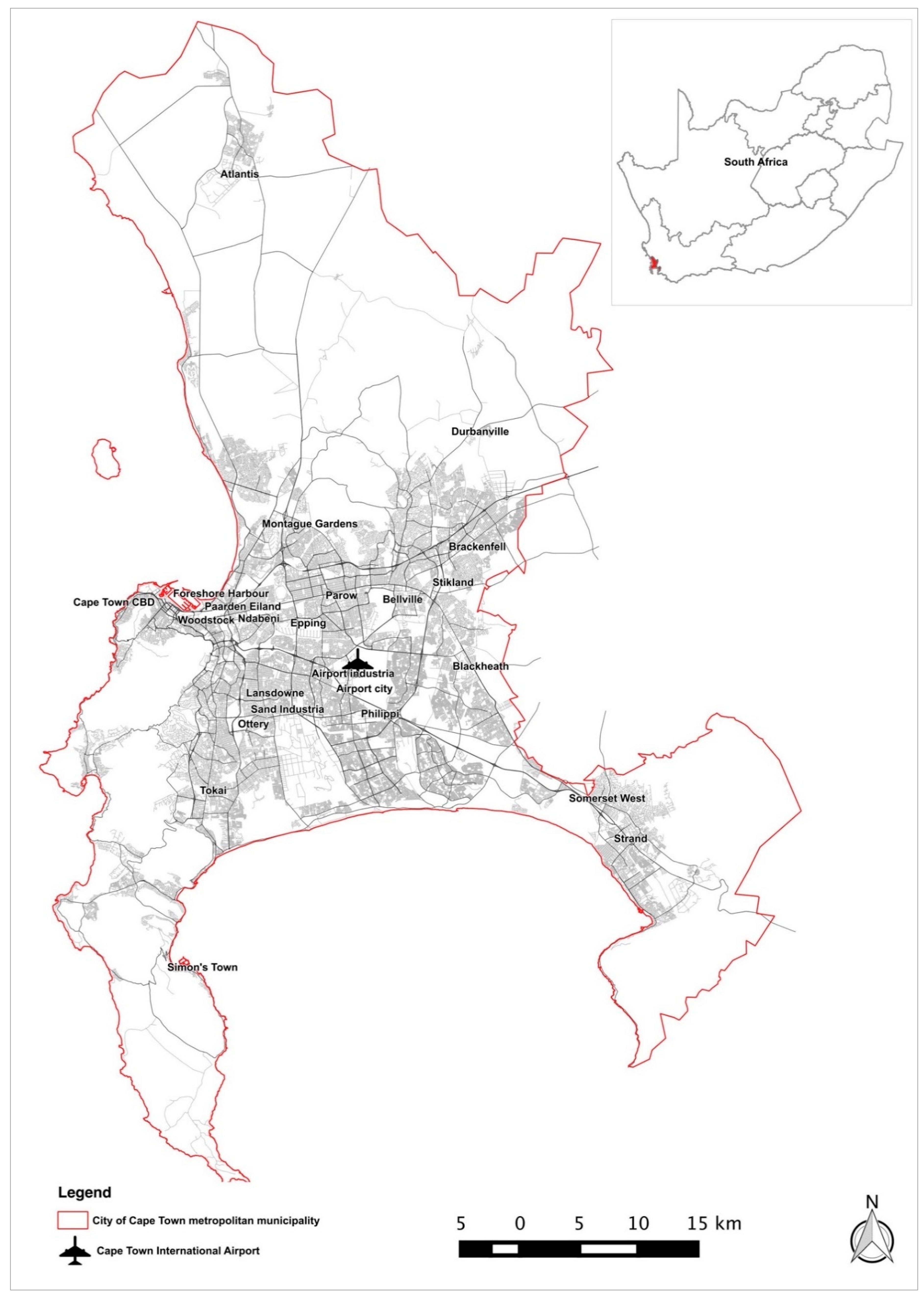
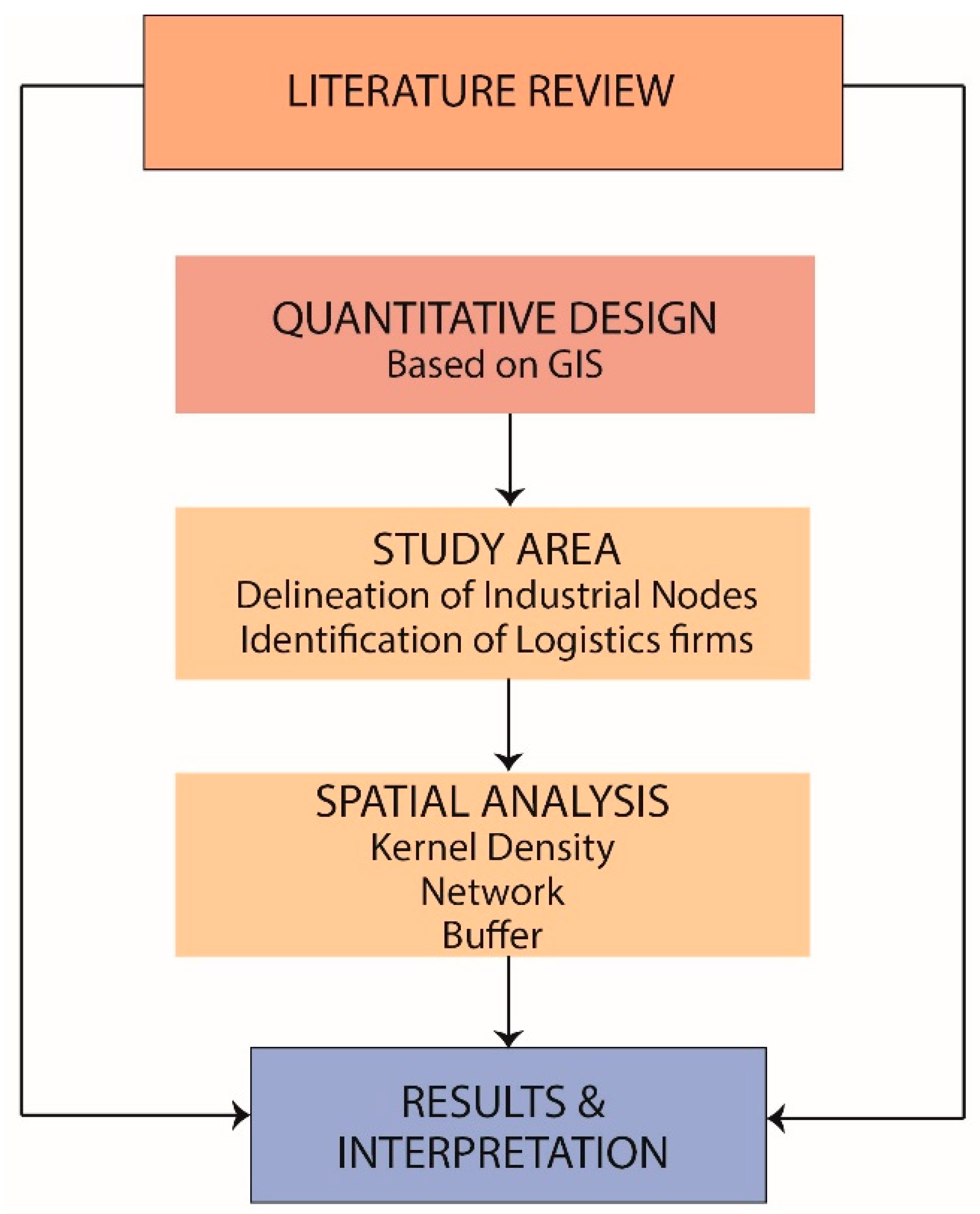


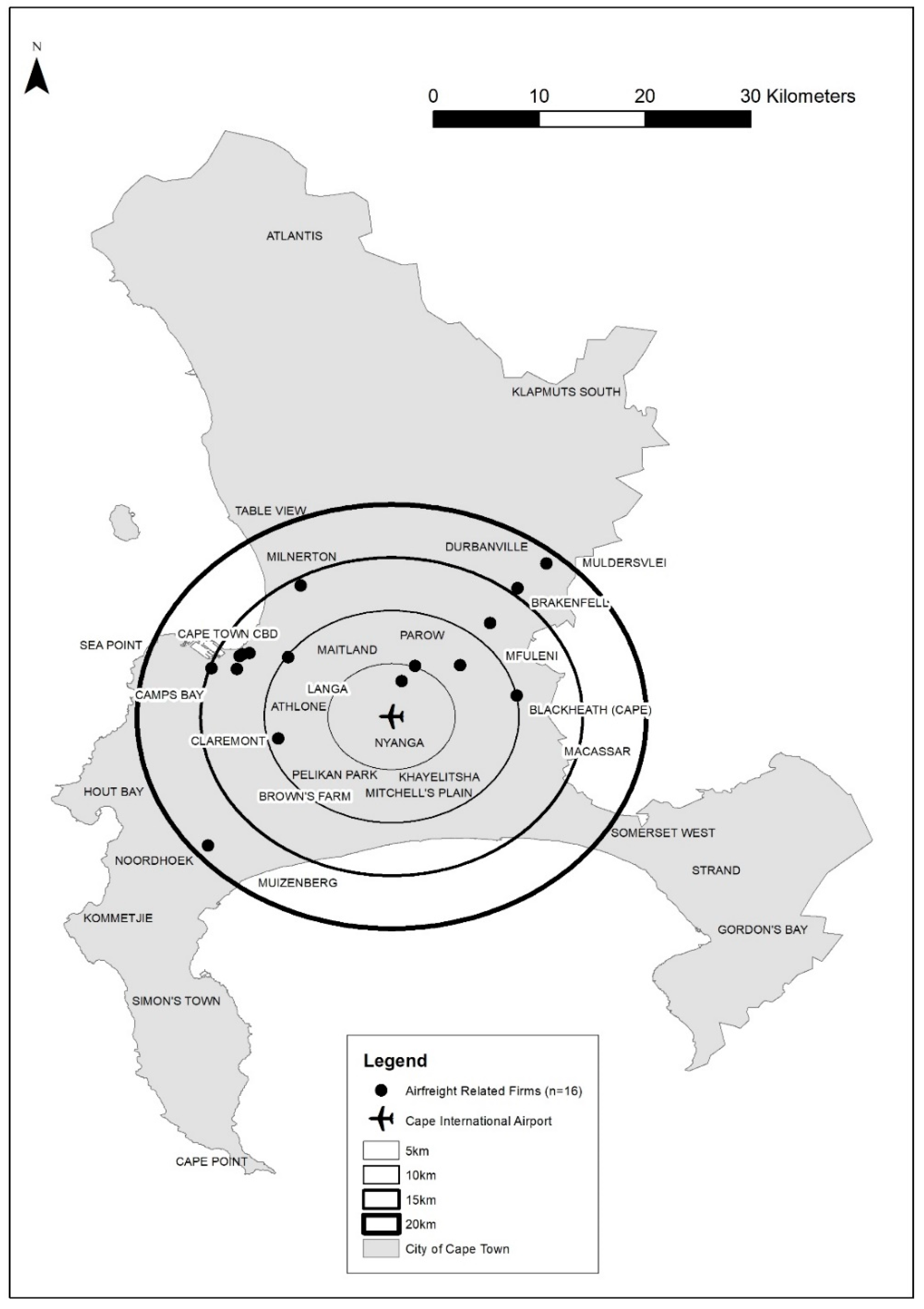
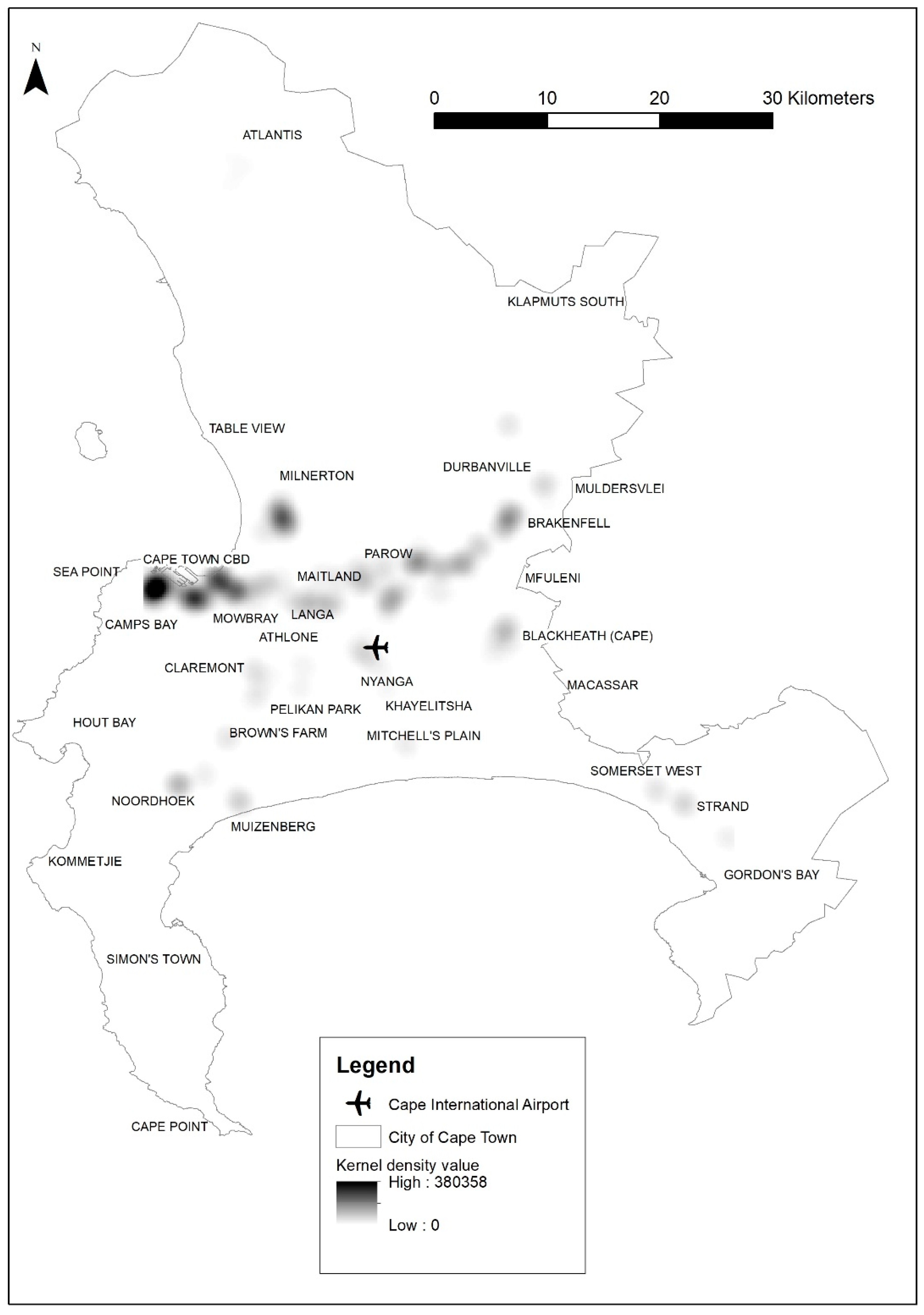
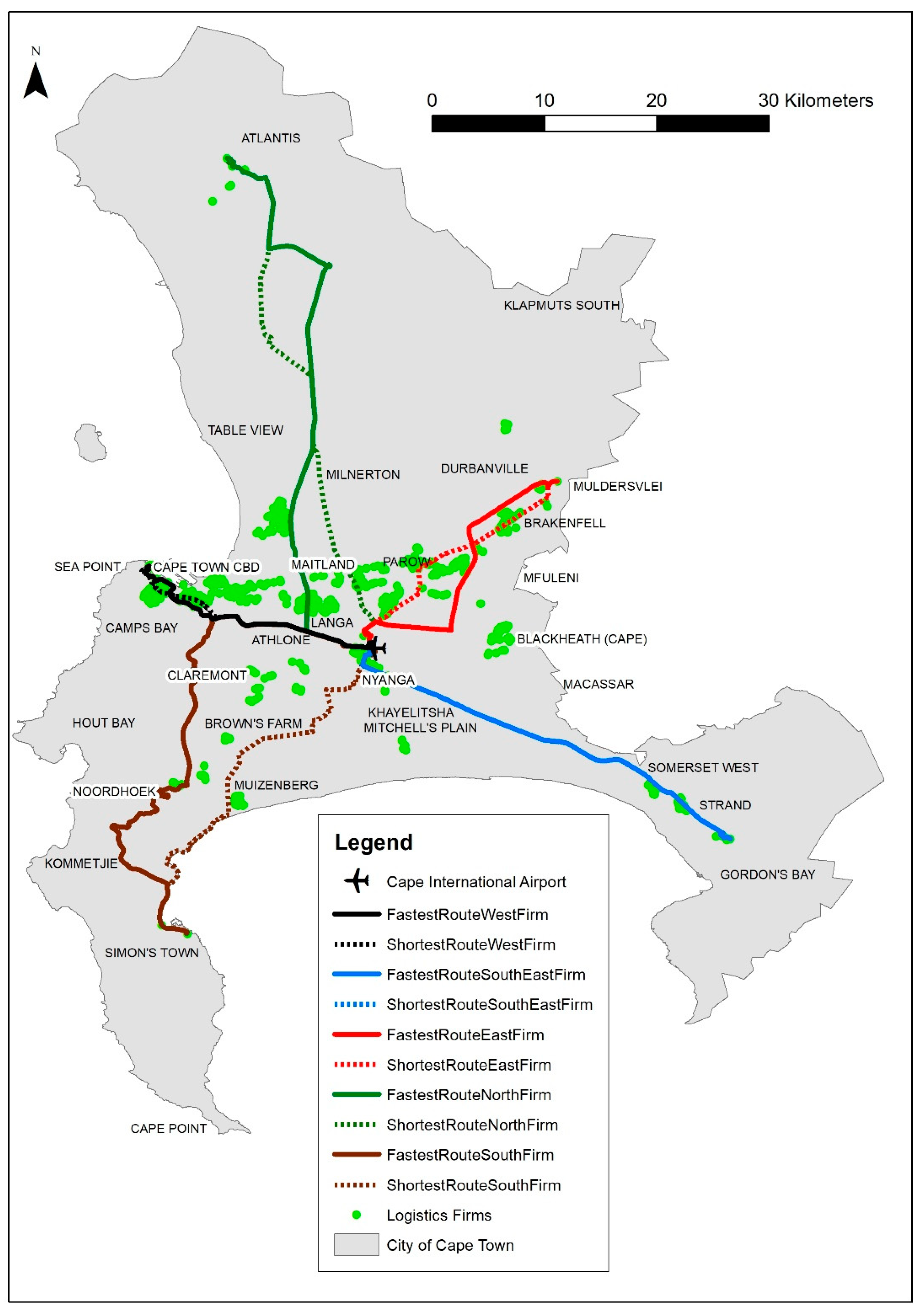
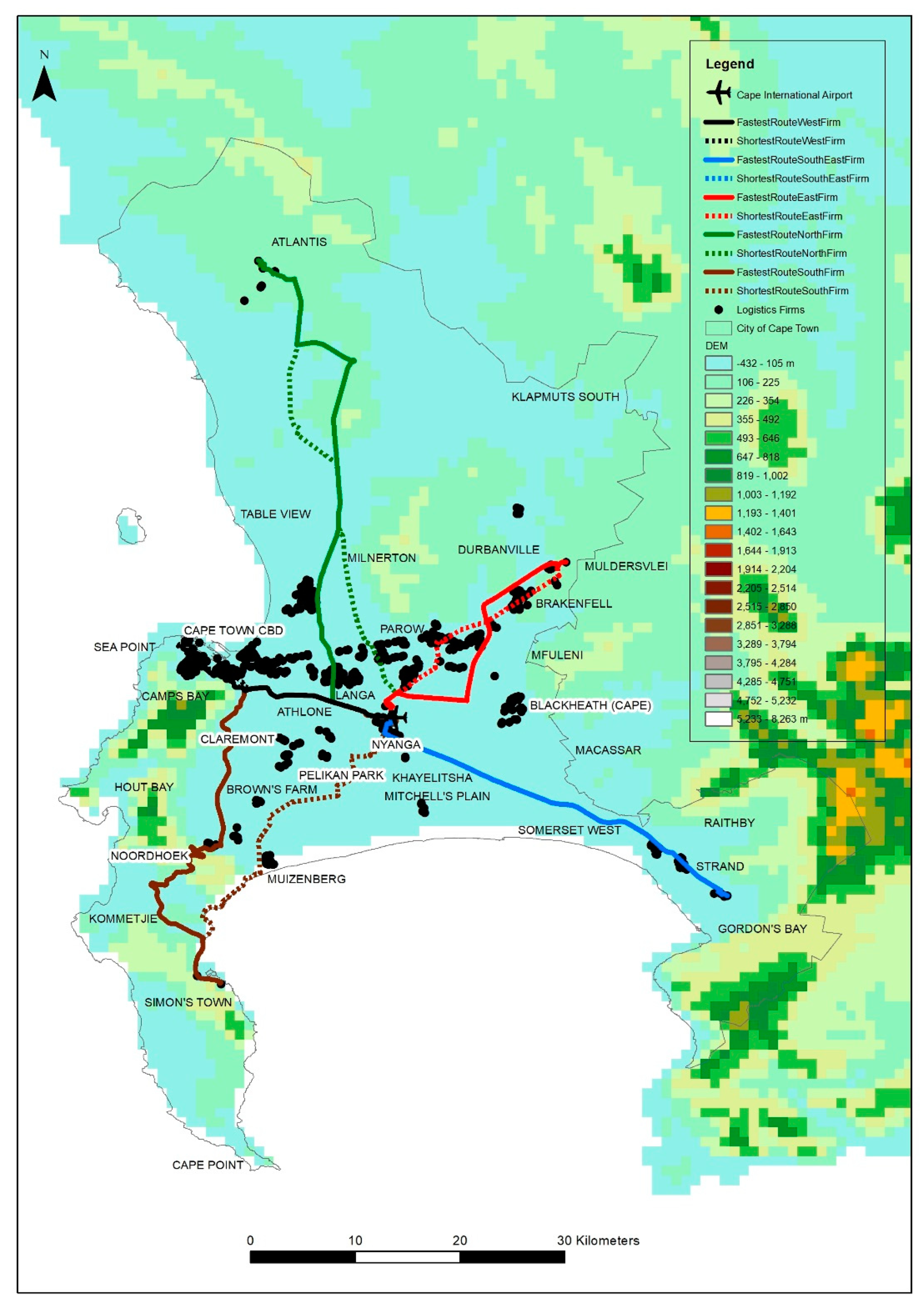
| Category | Number of Firms | |
|---|---|---|
| 1 | Distribution | 470 |
| 2 | Supplier | 190 |
| 3 | Logistics | 172 |
| 4 | Packaging | 92 |
| 5 | Warehousing | 20 |
| 6 | Courier | 22 |
| 7 | Transportation | 32 |
| 8 | Delivery | 10 |
| 9 | Freight | 44 |
| 10 | Trucking | 17 |
| 11 | Haulage | 8 |
| 12 | Movers | 13 |
| 13 | Removers | 28 |
| 14 | Parcel | 2 |
| Category | Number of Firms (AfriGIS Count) | Number of Firms 1 (Authors’ Count before Cleaning Data) | Number of Firms 2 (Authors’ Count after Cleaning Data) | |
|---|---|---|---|---|
| 1 | Distribution | 470 | 470 | 450 |
| 2 | Suppliers | 190 | 207 | 194 |
| 3 | Logistics | 172 | 172 | 169 |
| 4 | Packaging | 92 | 95 | 94 |
| 5 | Freight | 44 | 44 | 38 |
| 6 | Transportation | 32 | 31 | 30 |
| 7 | Warehousing | 20 | 22 | 22 |
| 8 | Courier | 22 | 21 | 20 |
| 9 | Removers | 28 | 28 | 18 |
| 10 | Trucking | 17 | 17 | 17 |
| 11 | Movers | 13 | 13 | 12 |
| 12 | Delivery | 10 | 11 | 9 |
| 13 | Haulage | 8 | 8 | 8 |
| 14 | Parcel | 2 | 2 | 2 |
| Fastest Route | Mode | Route | Distance (km) | Minutes | Route | Distance (km) | Minutes |
|---|---|---|---|---|---|---|---|
| North | Car | Fastest | 55 | 49 | Shortest | 50 | 64 |
| South | Car | Fastest | 36 | 33 | Shortest | 39 | 62 |
| East | Car | Fastest | 27 | 25 | Shortest | 24 | 39 |
| West | Car | Fastest | 22 | 26 | Shortest | 22 | 34 |
Publisher’s Note: MDPI stays neutral with regard to jurisdictional claims in published maps and institutional affiliations. |
© 2022 by the authors. Licensee MDPI, Basel, Switzerland. This article is an open access article distributed under the terms and conditions of the Creative Commons Attribution (CC BY) license (https://creativecommons.org/licenses/by/4.0/).
Share and Cite
Mokhele, M.; Mokhele, T. Spatial Configuration of Logistics Firms Relative to Cape Town International Airport, South Africa. Logistics 2022, 6, 49. https://doi.org/10.3390/logistics6030049
Mokhele M, Mokhele T. Spatial Configuration of Logistics Firms Relative to Cape Town International Airport, South Africa. Logistics. 2022; 6(3):49. https://doi.org/10.3390/logistics6030049
Chicago/Turabian StyleMokhele, Masilonyane, and Tholang Mokhele. 2022. "Spatial Configuration of Logistics Firms Relative to Cape Town International Airport, South Africa" Logistics 6, no. 3: 49. https://doi.org/10.3390/logistics6030049
APA StyleMokhele, M., & Mokhele, T. (2022). Spatial Configuration of Logistics Firms Relative to Cape Town International Airport, South Africa. Logistics, 6(3), 49. https://doi.org/10.3390/logistics6030049






